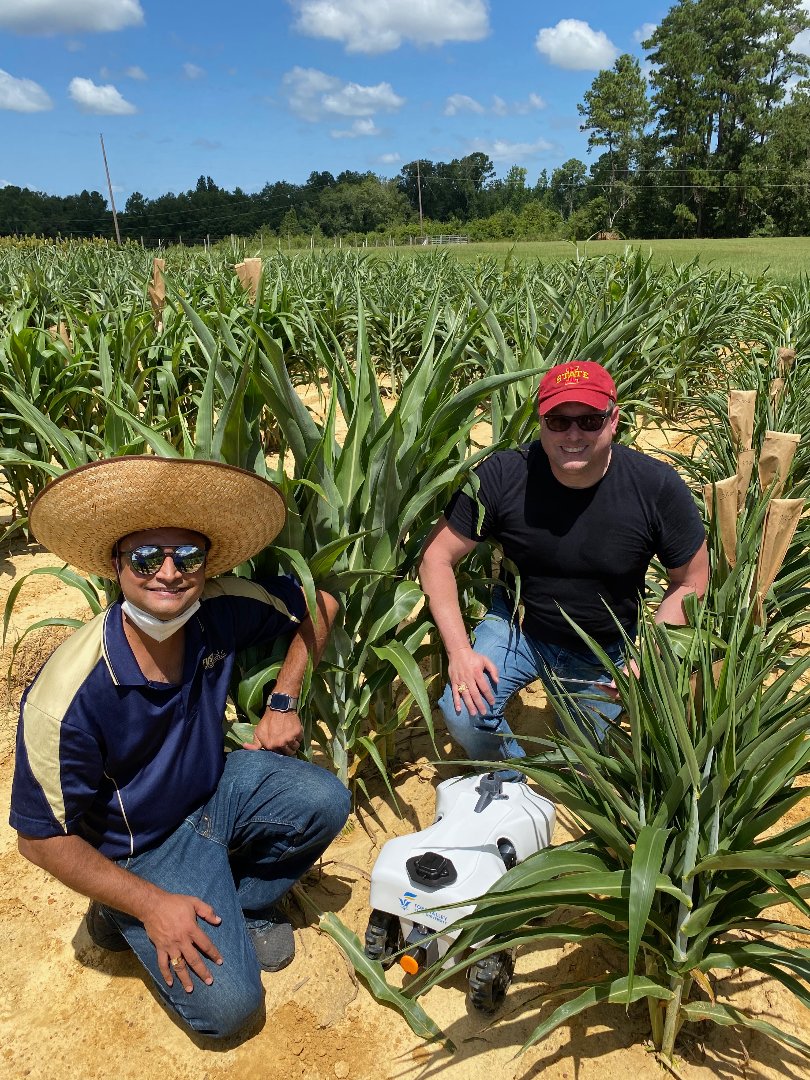An agricultural robot is giving a team of scientists a better view of a troublesome pest that is disrupting sorghum production in the Southeast.
Fort Valley State University research assistant professor Dr. Somashekhar Punnuri said the tiny sugarcane aphid (Melanaphis sacchari) has been a nuisance for southern farmers since 2013. This new invasive pest is severely reducing sorghum yield, forage quality and feed consumption. Sorghum is an important, versatile crop in the southern cropping systems, where farmers use it as forage and silage for livestock. In addition, it is valuable for bioethanol production.
For this reason, Punnuri aims to identify genetic resources that are resistant to sugarcane aphid and to strengthen the research capacity in plant breeding activities at the university. As principal investigator, he is collaborating with Drs. Joshua Peschel with Iowa State University and Jason Wallace with the University of Georgia (UGA). Other partners include Drs. Xinzhi Ni, Karen Harris-Shultz, Alisa Coffin and Joseph Knoll with the U.S. Department of Agriculture’s (USDA) Agricultural Research Service (ARS) in Tifton, Georgia, and Scott Armstrong with the USDA-ARS in Stillwater, Oklahoma.
Since starting the research process in 2019, they increased capacity for studying plant breeding of the sugarcane aphid, obtained a seed thresher, and installed a cold storage unit on FVSU’s campus for germplasm conservation and enhancement. Coffin and her crew collected drone data for aphid damage and other traits on the sorghum association panel (SAP). Dr. Addissu Ayele, FVSU postdoctoral research associate, also joined the group to assist on the project.
Additionally, Punnuri and his team held a workshop for 50 research and Extension professionals, students and farmers in fall 2019 to discuss strategies for management of the sugarcane aphid in sorghum, insect scouting using robots and plant-insect interaction-related studies. The researchers also conducted field demonstrations, where they trained participants on how to use an agricultural robot in the field.
In July 2020, Punnuri received a new TerraSentia robot from EarthSense Inc. to help improve their studies. He said there were battery and navigation issues with the old robot. However, the new robot contains six high-quality cameras, can withstand hotter temperatures, collects massive amounts of data, and can remain in the field for a longer duration. It also allows them to share the data in real time on cloud services. Dr. Chinmay Soman, co-founder and CEO of EarthSense Inc., helped train Fort Valley and other scientists on how to use this robot in the field for research purposes.
“We are going to modify it for our studies and use this data to identify sorghum genome regions,” Punnuri explained. “We are conducting a genome-wide study on a sorghum association panel with a few extra lines identified for sugarcane aphid resistance.”
The field-based robot will help increase the precision in phenotyping for sugarcane aphid damage and facilitate accelerated plant breeding. Phenotyping involves quantifying and characterizing a plant’s physiological growth and biochemical properties that attribute resistance to the plant. This allows the researchers to investigate the underlying genetic cause of a plant’s resistance to the sugarcane aphid.
Punnuri said the plant breeding community lacks the resources to precisely assess the damage caused by this pest. Currently, visual scoring is the only way to assess the pest problem and plant resistance offered.
“Sorghum acreage in Georgia has drastically reduced due to this menacing pest, which brings huge losses to sorghum farmers,” Punnuri said. “These farmers need pertinent information on how to control the losses caused by sugarcane aphid while keeping their costs low.”
He emphasized there is a lot to understand about this new pest. “We are seeing good results, and I am hopeful that we will make good progress on this project,” he said. “Phenotyping for insect resistance is difficult and developing such methods will help us provide varieties for breeders and farmers to combat sugarcane aphid problems.”
Upon completion, Punnuri plans to publish this research in a peer review article. He is also working on a USDA-ARS areawide pest management project headed by Ni. They are studying several field plots, and two FVSU undergraduate biology majors are receiving hands-on experience and using the data on sugarcane aphid for their senior research projects.
The USDA’s National Institute of Food and Agriculture (NIFA) awarded Punnuri a $499,997 Capacity Building Grant (GEOX-2018-04866) to fund the sugarcane aphid project.
For more information, contact Punnuri at (478) 825-6519 or punnuris@fvsu.edu.

